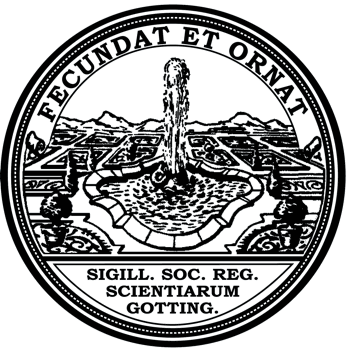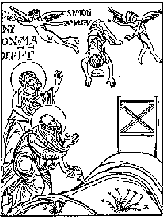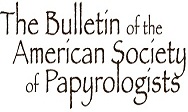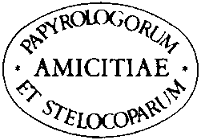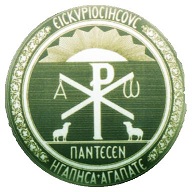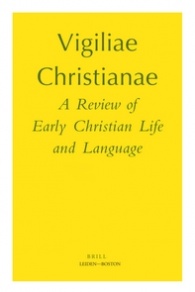
Shenoute and the Bible
International Conference
Georg-August-Universität Göttingen
17–21 May 2016
sponsored by:
 in conjunction with:
in conjunction with:
Critical Edition of the Works of Shenoute, Annual Meeting (“Shenoute 2016”)
Venue:
Tagungszentrum an der Sternwarte, Geismar Landstr. 12, 37083 Göttingen, Meeting Room 3 (except where noted otherwise in the program, or as announced during the meeting)
Tuesday 17 May
9.00–12.00:
• Heike Behlmer: Welcome, introductions, logistics
• Stephen Emmel: Meeting program, progress report
• Progress on the Critical Edition of the Works of Shenoute. Presentations by Tito Orlandi, Bentley Layton, Heike Behlmer, Frederik Wisse, Anne Boud’hors, David Brakke, and Zlatko Pleše
14.00–17.00:
• Stephen Emmel: Workshop on the critical editions and the translations of Shenoute’s
works (1st and initial session)
18.00–20.00 (Tagungszentrum, Meeting Room 1, “Großer Seminarraum”):
Showcase: Window onto Egyptian Monasticism
Schenute: Klostervorsteher und bedeutender koptischer Schriftsteller des 4./5. Jh. –
Shenoute: 4th/5th century abbot and eminent Coptic writer
Welcome address by the Sprecher des Sonderforschungsbereichs “Bildung und Religion”, Peter Gemeinhardt, Professor of Church History at the Georg-August-Universität Göttingen
• Stephen Emmel: “Schenute (ca. 348–465): koptischer Mönch, Klostervorsteher,
Schriftsteller”
• Bentley Layton: “The Structure of Monastic Life in Shenoute’s Monastery”
• Alin Suciu: “The Library of Shenoute’s Monastery: Center of Monastic Knowledge and
Culture”
• Frederik Wisse: “Shenoute and the Bible”
Wednesday 18 May
9.00–12.00:
• Ariel Shisha-Halevy: “On Puns, Alliteration and Paronomasy in Shenoute”
• David Brakke: “Making Shenoute an Author: Christian Literature in the Age of Lists”
14.00–16.00 (Lagarde-Haus, Friedländer Weg 11):
• Jürgen Horn: “Shenoute’s Importance in the History of Research on the Coptic Septuagint”
• Frank Feder et al., Akademie der Wissenschaften zu Göttingen: Presentation of the project “Digitale Gesamtedition und Übersetzung des koptisch-sahidischen Alten Testaments”
16:30-18:30 (Niedersächsische Staats- und Universitätsbibliothek Göttingen, Historisches Gebäude, Papendiek 14):
• Visit to the manuscript collection of the Niedersächsische Staats- und Universitätsbibliothek Göttingen: codices brought by Heinrich Brugsch from Wadi Natrun in 1870
Thursday 19 May
9.00–12.00:
• Sebastian Richter: “Recent Developments and Achievements of the ‘Database and Dictionary of Greek Loanwords in Coptic’ Project”
• Anne Boud’hors: “Some Thoughts about the Category of Pseudo-Shenoutean Texts”
• Frederik Wisse: “Canon 7, work 8, O Man: Introduction, Text, and Translation”
14.00–17.00:
• Sebastian Richter: “A Fragment of an (Anti?-)Origenist Dialogue on a 4th/5th-Century Papyrus Leaf from the Papyrus Collection of the Leipzig University Library”
• Stephen Emmel: Workshop on the critical editions and the translations of Shenoute’s works (2nd session)
18.00–21.00 (Hörsaal Theologicum T01):
• Ringvorlesung “Imaginiert und real, erschaut und erdacht: Christen in Ägypten und literarische Werke von und zu ihnen”
Martin Tamcke: “Von ‘Wir begannen, die Anachoreten in einem anderen Licht zu sehen’ zu ‘Jedermann braucht etwas Wüste’, Erhart Kästners (1904–1974) Zeltbuch von
Tumilat und die Kopten” (public lecture at 18.15)
followed by (from appr. 19.30: Foyer of the Kulturwissenschaftliches Zentrum, Heinrich-Düker-Weg 14)
• Reception; opportunity to visit the Seminar für Ägyptologie und Koptologie (Please RSVP by May 9 to: aegypten@uni-goettingen.de)
Friday 20 May
9.00–12.00:
Presentations by members of Göttingen projects on Shenoute and the Bible (SFB 1136 “Bildung und Religion” Teilprojekt B 05; KELLIA “Koptische/Coptic Electronic Language and Literature International Alliance”; “Digitale Gesamtedition und Übersetzung des koptisch-sahidischen Alten Testaments”)
• Uwe Sikora: Survey and recommendations on digital metadata standards, with particular regard to (Coptic) manuscripts and other objects
• So Miyagawa and Heike Behlmer: Processing non-biblical texts (e.g. Besa and Shenoute) for the Old Testament Virtual Reading Room and using text re-use software for detecting and describing (biblical) intertextuality
• Kirill Bulert and So Miyagawa: Optical character recognition (OCR) software for digitizing Coptic
• Diliana Atanassova: The White Monastery typika
14.00–17.00:
• Stephen Emmel: Workshop on the critical editions and the translations of Shenoute’s works (3rd session)
Saturday 21 May
9.00–12.00:
• Stephen Emmel: Workshop on the critical editions and the translations of Shenoute’s works (4th and final session)
• Heike Behlmer: Closing remarks and farewells
Speakers:
Dr Diliana Atanassova, Akademie der Wissenschaften zu Göttingen
Prof. Heike Behlmer, Universität Göttingen
Dr Anne Boud’hors, CNRS, Paris
Prof. David Brakke, Ohio State University, Columbus
Kirill Bulert, MPI für Biophysikalische Chemie, Göttingen
Prof. Stephen Emmel, Universität Münster
Dr Frank Feder, Akademie der Wissenschaften zu Göttingen
Dr Jürgen Horn, Hamburg
Prof. em. Bentley Layton, Yale University, New Haven, Connecticut
So Miyagawa, Universität Göttingen (SFB 1136)
Prof. em. Tito Orlandi, Rome/Hamburg
Prof. Zlatko Pleše, University of North Carolina, Chapel Hill
Prof. em. Ariel Shisha-Halevy, Toronto
Prof. Tonio Sebastian Richter, Freie Universität Berlin
Uwe Sikora, Universität Göttingen
Dr Alin Suciu, Akademie der Wissenschaften zu Göttingen
Prof. em. Frederik Wisse, Coldstream, British Columbia
Contact:
Seminar für Ägyptologie und Koptologie, Universität Göttingen, Heinrich-Düker-Weg 14, 37073 Göttingen
Ph.: +49 551 3924400 Email: aegypten@uni-goettingen.de
Download the programme as PDF.























